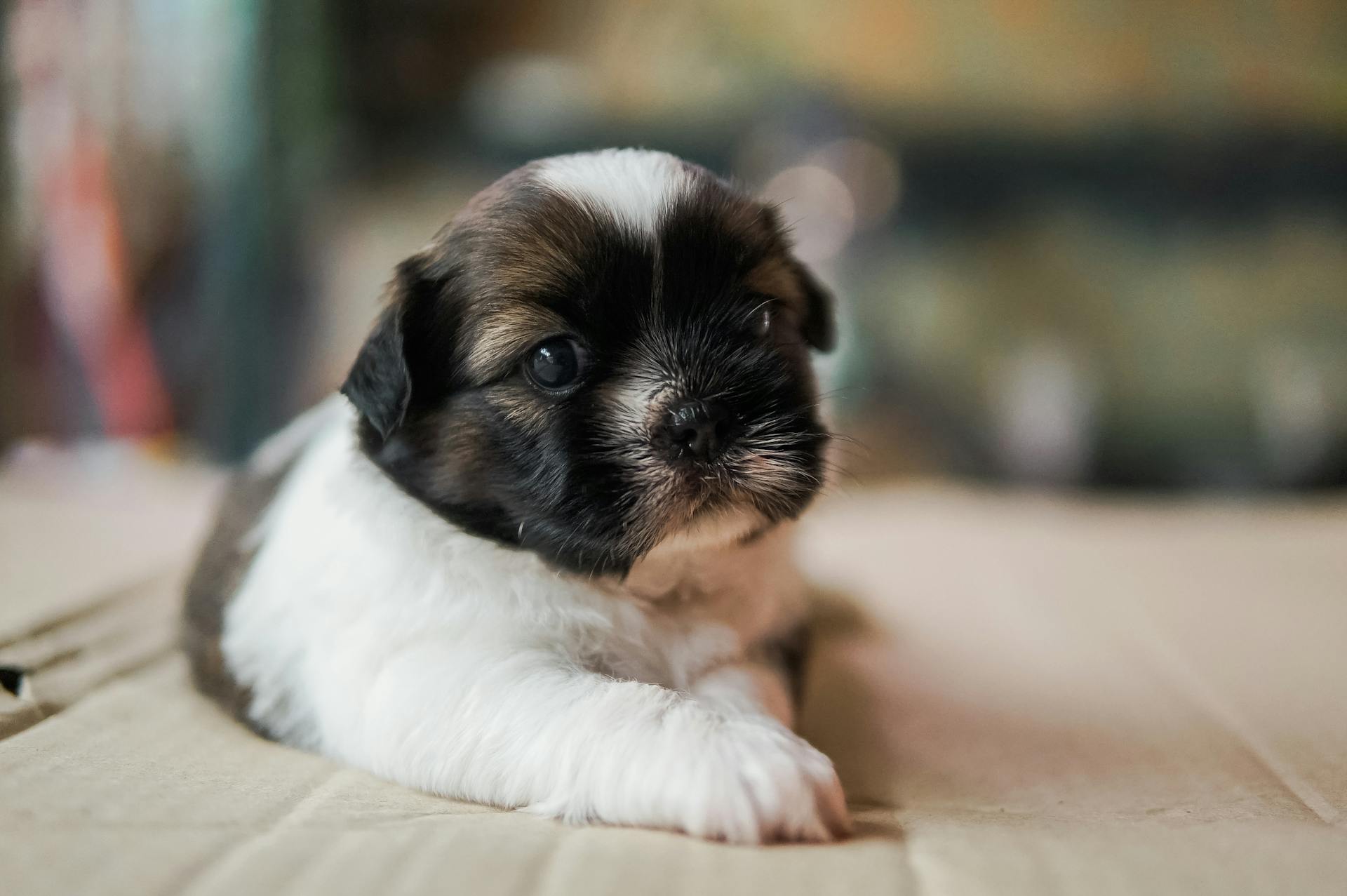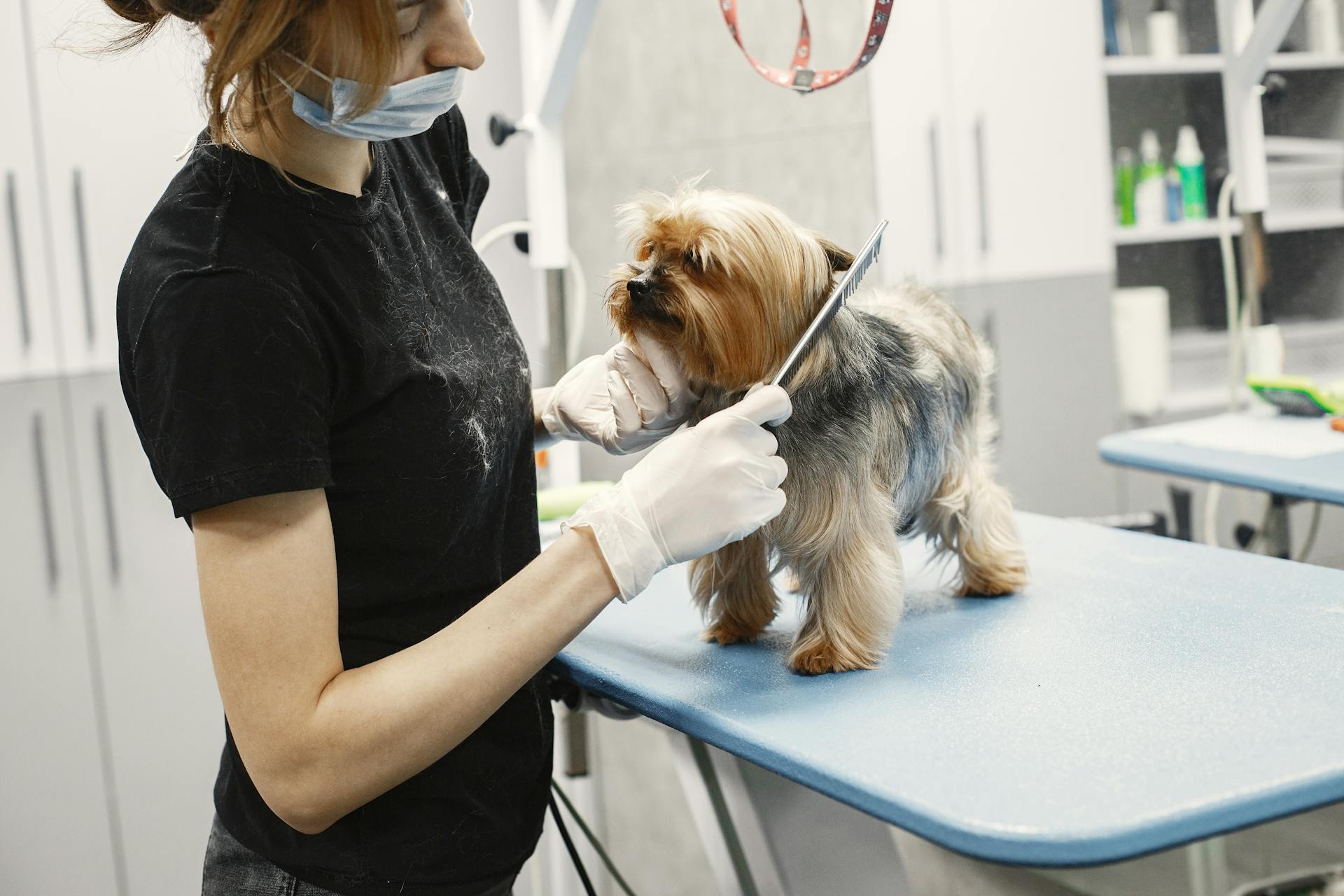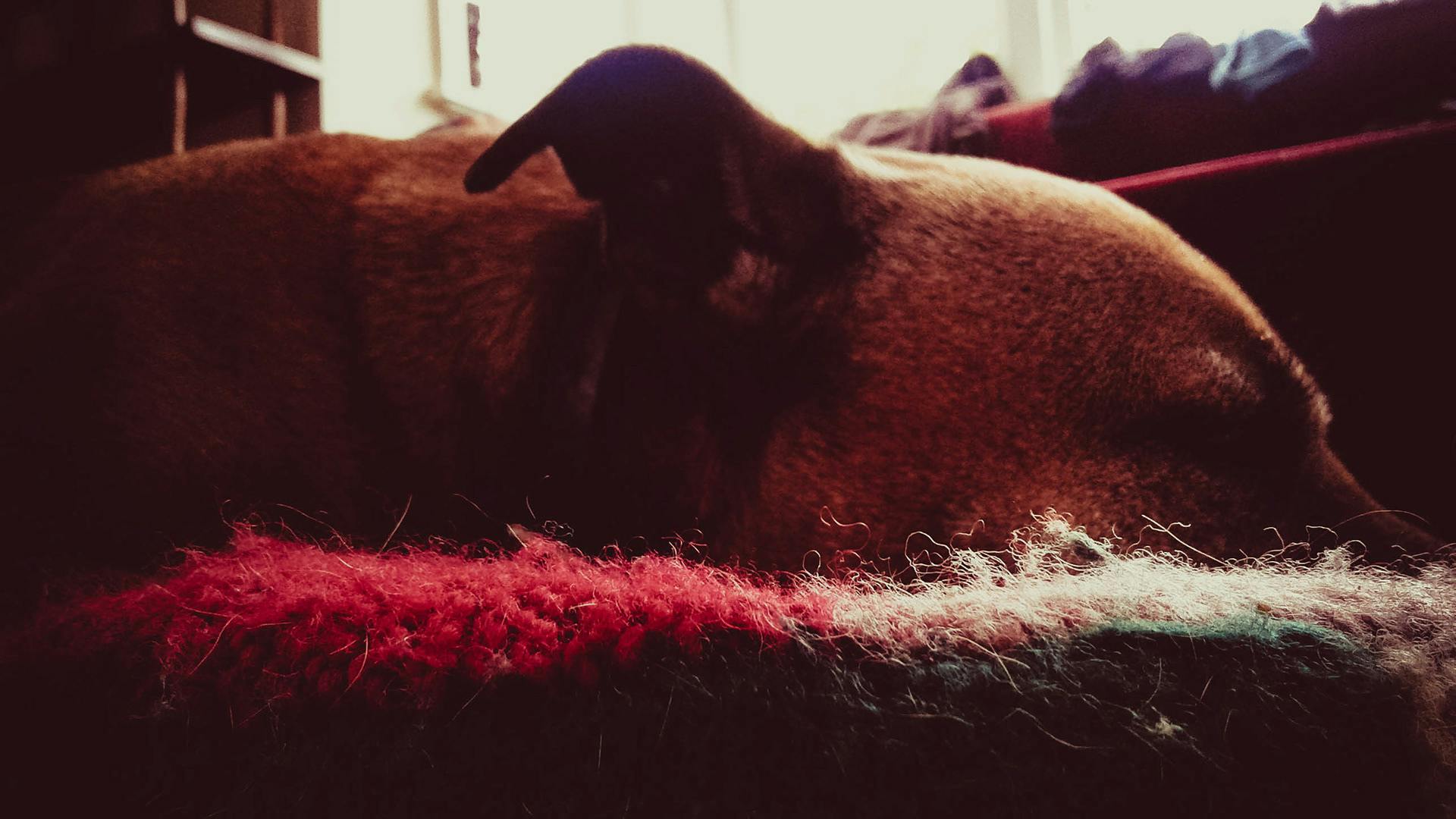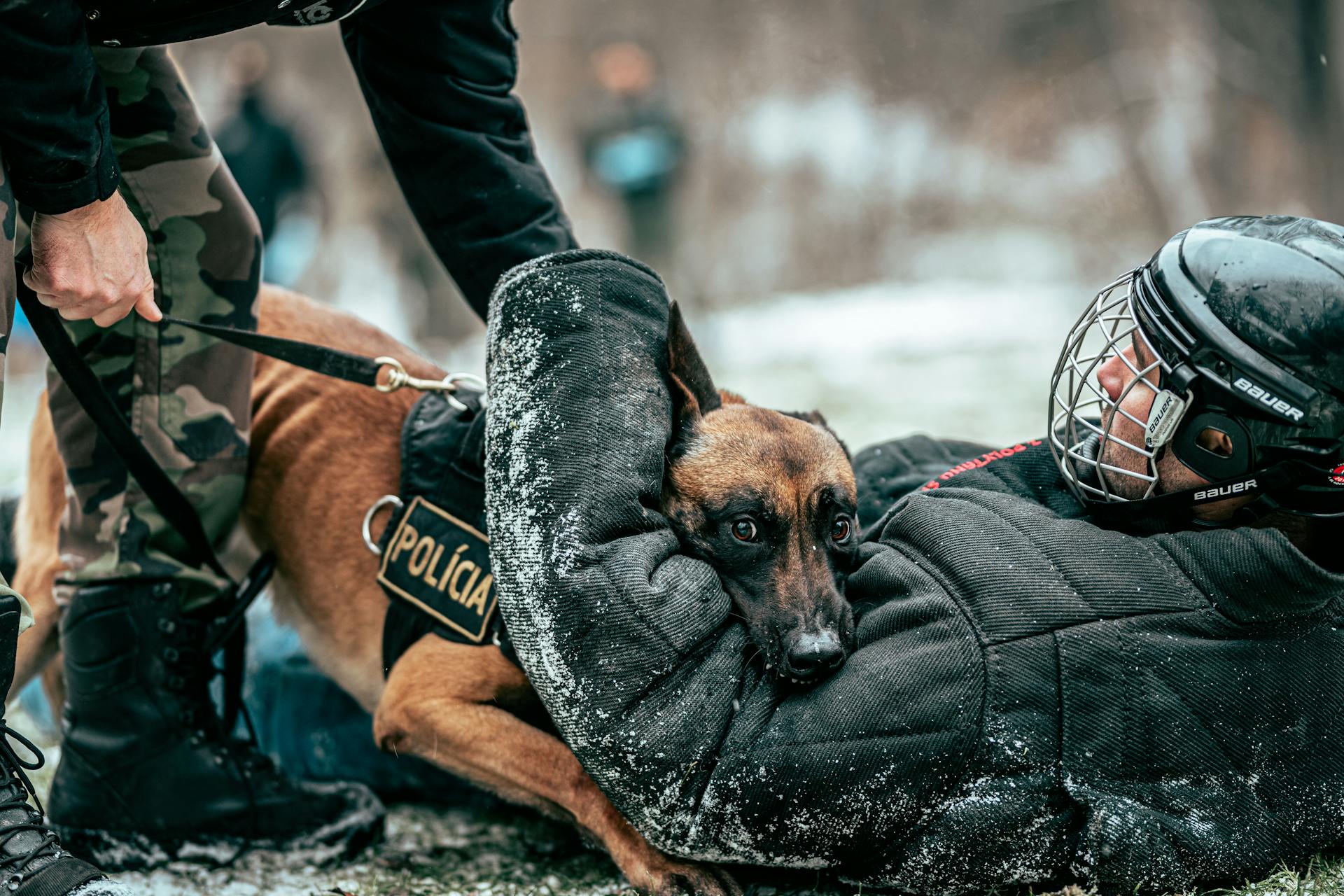
Matted Shih Tzu hair can be a real challenge to deal with, but understanding the causes is key to prevention. Shih Tzus are prone to matting due to their long, flowing coats.
Regular grooming is essential to prevent matting. This includes daily brushing to prevent knots and tangles.
Matting can be painful for your Shih Tzu, so it's crucial to catch it early on. Regular grooming sessions can help prevent matting from becoming a severe issue.
The frequency of grooming depends on your Shih Tzu's individual needs, but a good rule of thumb is to brush them at least 3-4 times a week.
Causes and Prevention
Mats often occur in areas of friction, such as under the collar, behind the ears, in the armpits, or on the lower legs where the legs rub together or where the dog comes into contact with grass.
Neglect and lack of grooming also cause tangles and knots. Regular brushing is key to preventing mats.
Static electricity and dryness can foster tangles, so adding a little moisture with a spray bottle while brushing can help. Pet parents should use a slicker brush with wire pins and follow the "line brushing" method with a gentle motion.
Brush a small section at a time, pushing the coat up with your hand to the line of the skin, patting the brush into the hair, and pulling away from the dog's body gently. Continue with this method of lifting, patting and gently stroking the brush through the coat a small section at a time.
Depending on the breed, you will want to brush your dog anywhere from once every couple of weeks to daily. Regular bathing is also essential, as a clean coat is less likely to knot.
Here are some high-friction areas to check for mats:
- Under the collar
- Behind the ears
- In the armpits
- On the lower legs
By being aware of these areas and brushing regularly, you can help prevent mats from forming in the first place.
What Is Matting?
Matting is a common issue that can occur in Shih Tzus, especially in areas with high friction, such as under the collar or behind the ears.
Mats and knots are more likely to form in dogs with longer coats, and Shih Tzus are no exception.
High friction areas can cause natural oils and skin cells to build up, leading to severe tangling and potentially damaging the skin.
Matted fur is an excellent hiding spot for fleas and ticks, making them difficult to see.
Some Shih Tzus may feel tempted to scratch their mats, which can cause skin tearing or irritation if their nails get caught.
Removing Mats
Removing mats from your Shih Tzu's hair can be a daunting task, but with the right tools and a gentle approach, you can do it safely and effectively.
You'll need a few essential tools to tackle mats, including a stainless steel comb, a pin brush, a de-matting tool, and a detangling spray.
Use your hands to locate each mat and try to loosen it up a bit with your fingers before using a comb or brush. This will help minimize tugging and make the process more comfortable for your dog.
It's essential to work through mats one by one, taking breaks as needed to avoid making your dog too tender or uncomfortable.
A special de-matting tool, like a dual-purpose brush, can be a game-changer for getting out mats and tangles. The dual-purpose brush has 22 teeth on one side for mat removal and a large side for thinning out the hair and de-shedding.
Here are some simple and effective methods for removing matted dog hair:
Remember to use your judgement and do what you're most comfortable with. If your dog's hair is severely matted or you're having trouble removing mats, it's always best to visit a professional groomer.
Tips and Techniques
Regular brushing is key to preventing mats in your Shih Tzu's coat.
Use a conditioning spray to help soften the coat and release tangles, especially when brushing your pup's hair has varying textures.
Begin by working from head to tail with a wide-toothed comb to eliminate any minor knots.
Using a slicker brush to work out dead hair, especially in the undercoat, is also crucial.
To smooth out the coat, use a pin or bristle brush as your final step.
To brush effectively, add a little moisture with a spray bottle, just a light mist, to prevent static electricity and dryness.
The "line brushing" method involves lifting the coat up with your hand to the line of the skin, patting the brush into the hair, and pulling away from the dog's body gently.
Here's a summary of the line brushing technique:
- Brush a small section at a time.
- Push the coat up with your hand to the line of the skin, pat the brush into the hair, and pull away from the dog’s body gently.
- Continue with this method of lifting, patting and gently stroking the brush through the coat a small section at a time.
Brushing frequency depends on the breed, but for Shih Tzus, it's recommended to brush anywhere from once every couple of weeks to daily.
Health and Safety
Mats on a Shih Tzu's coat can hide unseen injuries, such as a twig getting wrapped into the coat and scratching the skin, or even the hair itself causing tension on the skin.
Take a look at this: Shih Tzu Coat Type
These injuries can lead to tiny pin-sized bruises all over the dog's body, known as petechiae, caused by blood vessels under the skin breaking and causing bruising.
In extreme cases, the tension from the mats can tear the skin open, and I've personally found infected wounds on dogs caused by this.
Removing mats is crucial to prevent the risk of infection and promote healing.
The hair can also trap moisture near the skin, causing irritation known as hot spots, which can be relieved by removing the excess hair and allowing the skin to breathe.
As a groomer, it's essential to properly remove mats before cutting the coat to avoid a choppy, uneven cut and increase the risk of injury during the groom.
This is because the clipper blade will attempt to pull its way through the obstruction, potentially pulling the skin of the animal into the blade and causing lacerations.
A fresh viewpoint: Shih Tzu No Hair
General Information
Regular brushing is a must for Shih Tzus, even with a puppy cut. Brushing helps keep your dog's coat healthy.
You don't need to brush your Shih Tzu every day, but regular brushing is still essential.
Mats can form even on Shih Tzus with puppy cuts, so be prepared to deal with them.
Brush those mat-prone areas like the legs, belly, armpits, and behind the ears to prevent mats from forming.
Knowing When to Stop Painting
You're dealing with a situation where you're trying to fix something, but it's just not cooperating. You're like a dog owner trying to get the tangles out of their furry friend's hair, and it's a laborious process.
A 2-year-old will only tolerate so much tugging and pulling, and the same goes for your project. If it's taking too much time and effort, it's time to reassess your approach.
It's a matter of humanity before vanity. If it can't be saved, it's better to cut your losses and move on.
What If My Shih Tzu Has a Puppy Cut?
Even if your Shih Tzu has a puppy cut, regular brushing is still necessary to keep their coat healthy.
You won't need to brush your pup every day, but you should make it a regular habit to prevent mats from forming.
Mats can still form on Shih Tzus with puppy cuts, especially in areas like the legs, belly, armpits, and behind the ears.
To work out mats, use the tips provided and give your pup plenty of praise and a tasty treat when you're done.
Brushing regularly will help prevent mats from getting painful and frustrating for your pup.
Consider reading: Akc Shih Tzu Puppies
Frequently Asked Questions
Is matted fur painful for dogs?
Yes, matted fur can be painful for dogs as it can cut off air flow, trap moisture, and cause irritation and sores. Regular grooming is essential to prevent this discomfort and potential health issues.
Sources
- https://www.everythingshihtzu.com/shih-tzu-matted-hair.html
- https://urbanhounds.com/knot-sure-mats/
- https://www.barkavedog.com/services/matted-pups
- https://www.petmd.com/dog/grooming/dogs-hair-knots-how-get-them-untangled-and-under-control
- https://www.fourpaws.com/pets-101/grooming-gateway/prevent-and-remove-tangles-and-matted-dog-hair
Featured Images: pexels.com


